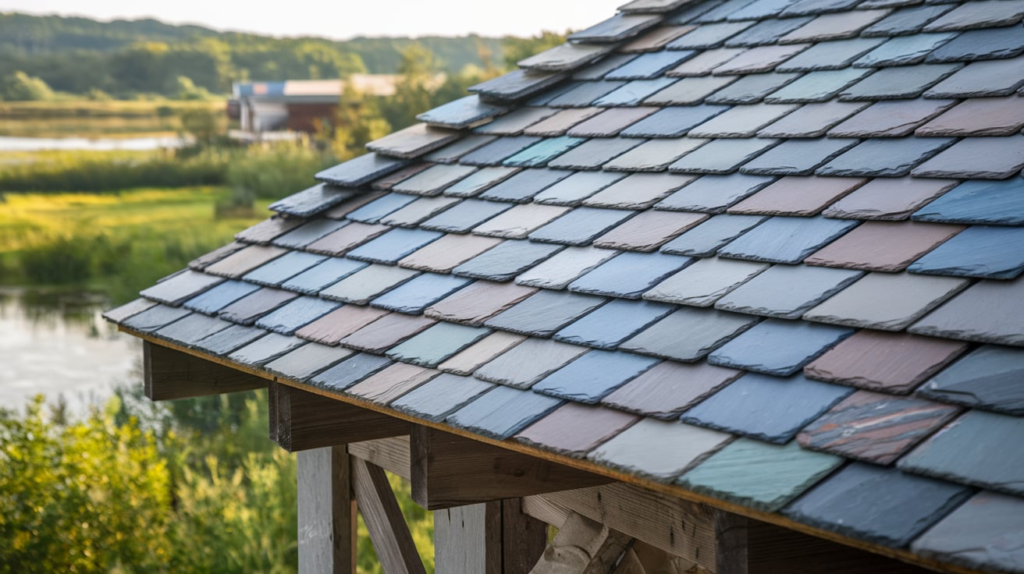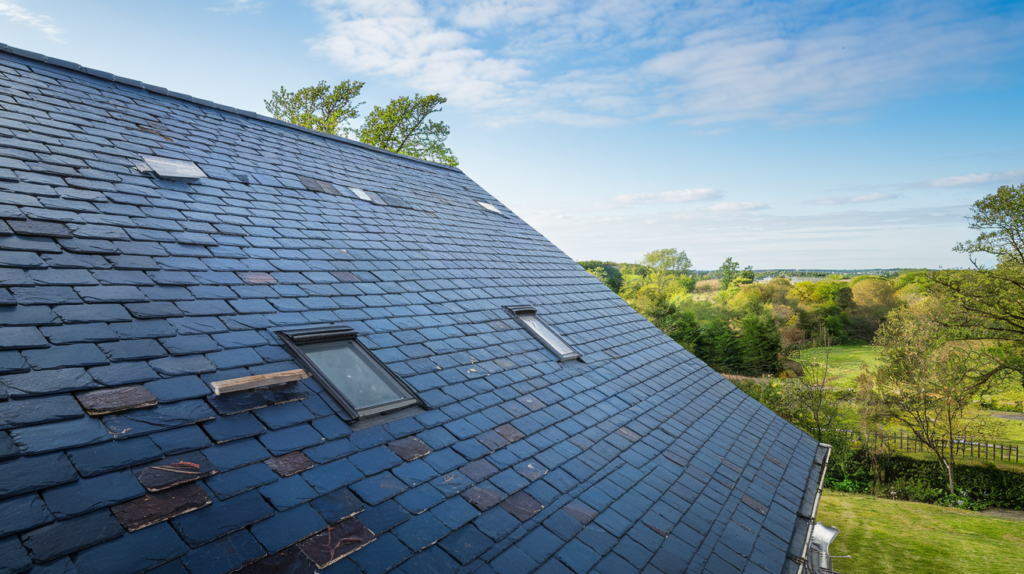Slate roofing is one of the most elegant, durable, and long-lasting roofing options available. Known for its natural beauty and timeless appeal, slate tiles can last for over a century when installed correctly, making them an excellent investment for Filipino homes.
With the Philippines’ unpredictable weather conditions—heavy rains, strong winds, and extreme heat—choosing a durable material like slate roofing ensures protection, value, and style. However, proper slate tile installation is crucial to maximize its benefits.
This guide will cover the best practices for installing slate roofing, from preparation to maintenance, to ensure a roof that stands the test of time.

Key Benefits of Slate Roofing
Before diving into the installation process, here are the top benefits of slate roofing:
• Durability: Slate roofs can last 100+ years with proper installation and maintenance.
• Weather Resistance: Slate tiles are resistant to heavy rains, strong winds, and high temperatures.
• Low Maintenance: Slate requires minimal upkeep compared to other roofing materials.
• Aesthetic Appeal: Available in natural colors and textures, slate tiles add a timeless, elegant look to any home.
• Eco-Friendly: Made from natural stone, slate is sustainable and recyclable.
• Fire-Resistant: Unlike wood or asphalt, slate roofing does not catch fire, making it a safer option.
Tools and Materials Needed for Slate Roofing Installation
Tools
• Slate cutter or tile saw
• Slate ripper (for removing tiles)
• Hammer and nails
• Nail hole punch
• Chalk line
• Ladder or scaffolding
• Safety gear (gloves, helmet, harness)
Materials
• Slate tiles
• Underlayment (breathable membrane)
• Roofing nails (copper, stainless steel, or galvanized)
• Flashing (metal strips for sealing edges and joints)
• Ridge tiles or capping slate
Best Practices for Slate Roofing Installation
Follow these proven best practices for a successful slate tile installation:
1. Plan and Prepare the Roof Structure
• Slate tiles are heavier than other roofing materials, so ensure the roof structure can support the weight.
• Consult a structural engineer to determine the required load-bearing capacity.
• Use sturdy roof framing with strong rafters and decking to hold the slate securely.
2. Choose the Right Underlayment
• A high-quality, breathable underlayment is essential to prevent moisture buildup and leaks.
• Use a roofing felt or synthetic membrane specifically designed for slate roofs.
• Install the underlayment smoothly, ensuring no wrinkles or gaps.
3. Select the Proper Slate Tiles
• Choose slate tiles of uniform thickness and size for a neat appearance.
• Inspect each tile for cracks or imperfections before installation.
• Use slate tiles with at least 5-6mm thickness for durability in Philippine weather conditions.
4. Layout and Mark the Roof
• Use a chalk line to create guidelines for even rows and alignments.
• Start at the bottom edge of the roof and work upward.
• Allow an overlap of 75-100mm between tiles to create a watertight seal.
5. Properly Nail Slate Tiles
• Use copper, stainless steel, or galvanized nails to prevent rust.
• Drive nails carefully into pre-punched holes on the slate tile. Avoid overdriving the nails, as this can crack the tile.
• Secure tiles at the top 1/3 section, allowing them to hang naturally.
6. Install Flashing for Water Protection
• Flashing protects valleys, ridges, and joints from water leaks.
• Use durable metal flashing (copper, aluminum, or stainless steel) to seal around chimneys, vents, and edges.
• Ensure the flashing overlaps the tiles to direct water away from vulnerable areas.
7. Use Ridge Tiles for a Polished Look
• Install ridge tiles or capping slate at the peak of the roof for a finished appearance.
• Secure them with nails and ensure they overlap the top rows of slate tiles.
8. Inspect for Proper Alignment and Gaps
• Check that each slate tile is aligned evenly and there are no large gaps between tiles.
• Ensure proper tile overlap to create a watertight and uniform look.
Common Mistakes to Avoid During Slate Tile Installation
To ensure a durable and long-lasting slate roof, avoid these common mistakes:
• Skipping Underlayment: Without a waterproof membrane, the roof is prone to leaks.
• Overdriving Nails: Driving nails too tightly can crack the slate. Allow tiles to hang naturally.
• Using Poor-Quality Nails: Nails that rust or corrode will cause tiles to loosen over time.
• Inadequate Overlap: Not overlapping tiles properly can lead to water infiltration.
• Neglecting Flashing: Poor flashing installation can cause leaks around chimneys, vents, and ridges.
Cost of Slate Roofing Installation in the Philippines
The cost of installing a slate roof can vary depending on factors like tile quality, labor, and roof size. Below is an estimate of the costs involved per square meter:
Slate Tiles: PHP 1,500 – PHP 3,000
Depending on tile quality
Underlayment: PHP 300 – PHP 500
Waterproof and breathable membrane
Flashing (Copper/Aluminum): PHP 500 – PHP 1,200
For sealing joints and valleys
Labor Costs: PHP 500 – PHP 1,200
Skilled labor for slate roofing
Note: Prices may vary based on supplier, location, and labor costs.
Maintenance Tips for Slate Roofing
A properly installed slate roof requires minimal maintenance, but regular inspections can extend its lifespan even further:
• Inspect Annually: Check for cracked, loose, or missing tiles, especially after storms or heavy rains.
• Clean Debris: Remove leaves, dirt, and moss to prevent moisture buildup.
• Check Flashing: Inspect flashing around chimneys and joints for damage or leaks.
• Replace Damaged Tiles: Use a slate ripper to carefully remove and replace broken tiles.
• Avoid Walking on Slate: Slate tiles can crack under pressure. Use boards or hire professionals for roof repairs.
Why Hire Professionals for Slate Tile Installation?
Slate roofing installation requires specialized skills and experience. Here’s why hiring professionals is a wise choice:
• Expertise: Professionals ensure proper nailing, alignment, and flashing to prevent leaks and damage.
• Safety: Installing slate tiles can be dangerous due to the roof’s height and weight. Professionals follow safety protocols.
• Efficiency: Skilled installers complete the job faster and more accurately.
• Long-Lasting Results: A professionally installed slate roof will last for decades, providing excellent value for your investment.

Conclusion: Invest in Slate Roofing for Your Home
Slate roofing is a durable, elegant, and eco-friendly choice for Filipino homes. With proper installation and maintenance, slate tiles offer unmatched beauty and protection that can last for over a century.
To ensure long-lasting results, follow these best practices:
• Prepare a strong roof structure.
• Use quality materials like slate tiles, proper nails, and flashing.
• Install tiles carefully, ensuring correct overlap and alignment.
• Regularly inspect and maintain the roof for damage or wear.
Looking for professional slate tile installation? Contact our team of experienced Filipino roofing contractors today! We’ll help you build a stunning and durable slate roof that adds value and beauty to your home.
